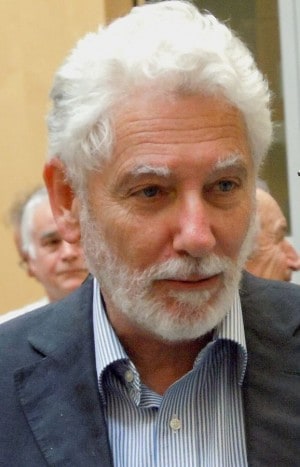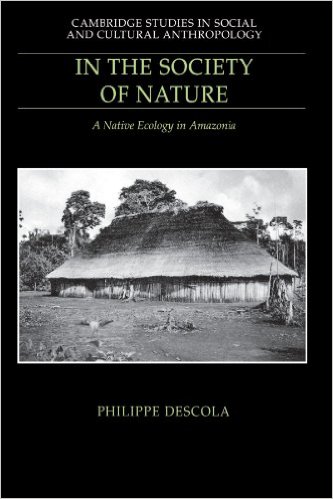An academic interview is just a snapshot but it can offer a vivid account of a life’s work. The following is an edited version of an interview with Philippe Descola, whose distinguished career includes many innovative contributions to debates in the ethnography of Amazonia and anthropological theory, which have played a large part in the so-called ontological turn of contemporary anthropology. I had the privilege to interview Professor Descola, who currently holds the Chair in the Anthropology of Nature at the Collège de France, when he visited Helsinki to attend the Biennial Conference of the Finnish Anthropological Society and deliver the Edward Westermarck Memorial Lecture, entitled “Landscape as Transfiguration.”
My first question was about Professor Descola’s transition to anthropology from his early studies in philosophy and how he embarked on his ethnographic project with the Achuar of the Upper Amazon. He talked in response about the long tradition in France of prominent social scientists, such as Durkheim and Lévi-Strauss, converting from philosophy to anthropology. Although he commended the training provided by the French method of teaching philosophy as the history of discursive formations, he recalled feeling:

“…dissatisfied by the fact that the questions that were being asked were the questions that had been asked ever since 2500 years ago from the Greeks onwards about being, about truth, about the legitimacy of certain kinds of scientific propositions about morality etc., without taking into account other ways of asking these questions that had been observed by anthropologists and historians elsewhere. “So there was a self-centered dimension to philosophy which I found problematic. This is why, rather than being interested in experiments of thought, like many others in France I began to be interested in real life experiments of how people lead and organize their lives – questions that were not conceivable in the philosophical panorama in general.”
About his early interest in anthropology, he said:
“I had read Tristes Tropiques when I was 16 or 17 and I was fascinated, not so much by the Indians in the book because it’s an intellectual biography, but by the man, Lévi-Strauss, someone who was at the same time obviously a very learned and sensible person, who wrote very well with a very incisive mind, who could write as well on Debussy and Rousseau and the Bororo Indians in Brazil. This form of humanism, of very broad culture, fascinated me in the person. So I said, ‘if this person is an anthropologist, then anthropology must be a fascinating science also.´”
At the time, in addition to reading classic texts of structural anthropology, Professor Descola was one among many in his generation who were immersed in the texts of Marx and Engels. He soon found, in a book entitled Rationality and Irrationality in Economics by the young Maurice Godelier, recently returned from fieldwork in New Guinea, an analysis of pre-capitalist modes of production that fascinated him. Here was, he recalled, “a rigorous way to enter the question of the diversity of forms of life in the world. So that’s when I decided to become an anthropologist.”
After an initial stint of fieldwork in the southern Chiapas in Mexico, which failed to provide the inspiration he felt he needed to conduct a long-term ethnographic project, Professor Descola revived earlier plans to do fieldwork in Amazonia. Going over reasons of this, the main one was that notwithstanding Lévi-Strauss’s work on mythology and a few good ethnographies, anthropologists knew next to nothing of Amazonia and Amazonian people at the time.
Reading the long record of ethnographic literature on Amazonia revealed a leitmotif of Amazonian people as mysterious and enigmatic—as French chroniclers of the Brazilian coast in the 16th century wrote, they were “Without Faith, King or Law”—meaning they exhibited few or none of the institutions like villages, chiefs or rituals that Europeans expected them to have.
Perusing the texts, Professor Descola noticed that:
 “What they all emphasized was that these people were naturals. They were in fact in a way glued to nature. Either positively, in Montaigne’s sense as naked philosophers, or as groups intent on killing each other, incapable of controlling their natural instincts… I was struck by this and I thought there must be something in their relation to nature for this leitmotif to go on for centuries. And at the time the main type of publications on Amazonia in the United States belonged to the so-called cultural ecology school, which was extremely reductionist and interpreted all cultural features as products of adaptation to nature, so there was a continuity in that sense. So I left for fieldwork with the idea of studying in depth how these people related to what I still called at the time, ‘nature.’”
“What they all emphasized was that these people were naturals. They were in fact in a way glued to nature. Either positively, in Montaigne’s sense as naked philosophers, or as groups intent on killing each other, incapable of controlling their natural instincts… I was struck by this and I thought there must be something in their relation to nature for this leitmotif to go on for centuries. And at the time the main type of publications on Amazonia in the United States belonged to the so-called cultural ecology school, which was extremely reductionist and interpreted all cultural features as products of adaptation to nature, so there was a continuity in that sense. So I left for fieldwork with the idea of studying in depth how these people related to what I still called at the time, ‘nature.’”
My next question was about the process of gaining ethnographic insight and how his experiences in the Ecuadorian Amazon with the Achuar continued to inspire him. He responded that doing ethnography in unfamiliar settings is useful because it leads to astonishment, which he said is crucial in creating the epistemological distance that destabilizes one’s assumptions:
“And this is why Amazonia was very interesting, because it was perhaps the farthest one could go in terms of differences. There was a sort of logical scandal in these people. Where was society there? Especially among the Achuar, who were living in a completely scattered habitat, feuding amongst themselves, having no chiefs… I had heard a very interesting description by a Dominican missionary at the end of the 19th century who said the Achuar had no religion except birdsongs and dreams. And that was very clever to understand, because dreams are one of their means of communication with the spiritual dimension of nonhumans, and birdsongs are songs that the Achuar and the Jivaro in general sing constantly in order to connect with them. So he had a clear idea that their religion was that, but this lucidity was not very common at the time.”
Professor Descola then recounted a memorable incident from his fieldwork that occurred when a woman in whose house he was staying was bitten by a dangerous snake by the river. He was able to help her by giving her a serum injection, but her husband was “completely devastated” and blamed himself for the incident.
“I tried to speak with him to lift up his spirits, but he said it was his fault because it was the revenge of the Master of the Animals. The day before he had gone to the forest with a new shotgun – he used to hunt before with his blowgun only – and he killed many more of a troop of woolly monkeys than he would have needed to. “It’s a very classical story among hunters everywhere in the world: his hubris made him responsible for the revenge that took the form of a snake bite on his wife.”

Becoming acquainted with such entanglements, Professor Descola said, takes time as one learns the local language which appears, in a lively image, like disconnected subtitles of a film. Although people were forthcoming, until they were able to converse he and his wife were accepted, he recalled, as interesting distractions to observe. Over the first few months of fieldwork, Professor Descola gathered data on the use of plants and animals. Of this process, he said:
“Progressively, I came out of this gathering of technical and quantifiable material to understand what people were saying about the things I had been measuring. And obviously, there was a huge void between what I was considering at the time, which was the way these people were adapting to their environment, and the way they thought about it, which was as a series of interactions with nonhumans treated as social partners. “So that’s when I came to realize that it was absurd to think of a society adapting to a natural environment. ‘Nature’ and ‘society’ were useless concepts for that.”
 These experiences became the basis for Professor Descola’s first monograph, published in English as In the Society of Nature. The book describes how Achuar ecological practices were deeply interwoven with cosmological ideas connecting the lives of humans with plants, animals and spirits in an encompassing web of social relations. When I asked about its theoretical influences, Professor Descola noted that many people at the time were grappling with combining the incompatible approaches of Marxism, structuralism and phenomenology. He recalled his dissatisfaction with the materialist perspective that predefined society in terms of causally related layers, from the material base to the ideological system, and with the structuralist idea of “nature as good to think with,” or of nature as “a sort of catalogue of properties, which the mind uses in order to construct interesting and complex combinations in myth and classification.”
These experiences became the basis for Professor Descola’s first monograph, published in English as In the Society of Nature. The book describes how Achuar ecological practices were deeply interwoven with cosmological ideas connecting the lives of humans with plants, animals and spirits in an encompassing web of social relations. When I asked about its theoretical influences, Professor Descola noted that many people at the time were grappling with combining the incompatible approaches of Marxism, structuralism and phenomenology. He recalled his dissatisfaction with the materialist perspective that predefined society in terms of causally related layers, from the material base to the ideological system, and with the structuralist idea of “nature as good to think with,” or of nature as “a sort of catalogue of properties, which the mind uses in order to construct interesting and complex combinations in myth and classification.”
Having learned that the Achuar were concerned with nonhumans as social partners, rather than with nature as an intellectual problem, Professor Descola realized one had to do away with “nature” altogether, and turned his attention to how people interact with nonhumans.
Subsequently, in his first teaching position, Professor Descola ran a research seminar exploring this question in societies neighboring the Achuar and progressively in other parts of the world. He discovered that the features he observed among the Achuar were very common in Amazonia, based on the fact that game animals were considered as affines, generally defined as in-laws, and noted the complexity and usefulness of this qualifying relationship. Recalling the beginning of an important scholarly relationship, Professor Descola recounted:
“This is when I began to read Eduardo Viveiros de Castro, who took affinity from the point of view of the relationship with humans, while I was interested in affinity as the relationship with nonhumans, and we discovered that there was a continuity. We arrived to affinity from different perspectives and interests: he came to affinity by studying cannibalism and Tupian attitudes towards affinity, while I came to it by studying the relationship with game animals, and we discovered that it was the same realm of social relations, in general.”
Through systematic discussions with his seminar students and extending his ethnographic focus to North America and Siberia, Professor Descola discovered that there, too, people related to game animals through a relationship of affinity. Realizing this could not be attributed to a hunter-gatherer mode of life in places like Amazonia with an 8000-year-history of plant domestication, he concluded it had to be “a specific outlook towards nonhumans that is found in different places of the world. And this is when I decided to revive this old concept of animism, which had fallen into disrepute.”
 Given that cultivated plants were also related to in terms of a Dravidian kinship category, consanguinity, Professor Descola had a basis for his initial theory of animism, which he then gradually developed in conversation with his main “sparring partners” Eduardo Viveiros de Castro, Bruno Latour and Tim Ingold. These discussions and reading ethnographies of Aboriginal Australia indicated that the initial contrast he made between animism and Lévi-Strauss’s theory of totemism, a seemingly reverse case of treating differences between social groups in terms of categories of nonhumans, was “too classificatory.”
Given that cultivated plants were also related to in terms of a Dravidian kinship category, consanguinity, Professor Descola had a basis for his initial theory of animism, which he then gradually developed in conversation with his main “sparring partners” Eduardo Viveiros de Castro, Bruno Latour and Tim Ingold. These discussions and reading ethnographies of Aboriginal Australia indicated that the initial contrast he made between animism and Lévi-Strauss’s theory of totemism, a seemingly reverse case of treating differences between social groups in terms of categories of nonhumans, was “too classificatory.”
This was how he came to formulate the combinatorial matrix of four ontological modes put forth in his book Beyond Nature and Culture, first published in 2005. It stemmed from realizing that:
“…the relationship between what I call animism, totemism and naturalism—which is “our” way of doing things since the 17th century, if you wish to give a date—and what I called analogism, were all transformations of each other, as transformations of an initial contrast between, on the one hand, interiority and physicality, and on the other hand, difference and resemblance, which provided a sort of initial matrix to differentiate ways of detecting continuities and discontinuities between humans and nonhumans…”
In response to my question about how he intended this model of ontologies to be used, Professor Descola explained that he wrote the book not knowing how it would be received, having since been pleasantly surprised by the diverse interest it has generated. He continued that his intention was to provide analytical tools to go beyond classical social science concepts like history, society and nature.
This implies, he emphasized, studying the elementary systematizations of detecting continuities and discontinuities in the world that people learn in their native social settings, which appear to fall into one of the four ontological modes.
“These are models intended as an analytical device to understand the conditions for bringing together, in what I call collectives, certain features and excluding other features. It’s a heuristic model in that sense… I speak of collectives because I’m interested in the form of aggregates that exist all over the world with humans and nonhumans. “We” naturalists are one of the aggregates. We decided that there were beings which were natural and beings which were humans. This was a very important dividing line with a lot of consequences, and this dividing line resulted in the fact that we deal with societies as societies of humans. So we have excluded nonhumans from our collectives. Others have brought them into their collectives, but in very different fashions.”

He then offered views on the need for an ontological sensibility in anthropology:
“What we have to study and understand is how people constitute these aggregates, and this is repeatable for every other concept. The subject, for instance: a subject is not necessarily derived from the individual subject as it is conceived in the west. And epistemology, which is in fact a reflection on what is knowable, is not either something that can be understood as it is in the west under the conditions of the truth of statements. So every philosophical or metaphysical problem that has been posed in the west has been posed in a different manner elsewhere, and you have to go beyond the traditional concepts to understand them. This is why it’s ontological. You cannot say it’s sociological because being sociological would mean that society would explain everything, which is not the case. Society is the product, the thing to be explained. It’s not the explanatory factor.”
Professor Descola went on to reflect that this reframing of the intellectual basis of the social sciences has certain political implications, due to the ontological underpinnings of processes of massive ecological change, resulting among other causes from the divisive conceptualization of nature and society in the modern ontological mode:
“This idea is partly responsible for the current situation. It was responsible for very good things also. I’m not a moralist… I think it’s a partial apprehension of the world. Any ontology leads to a specific systematization of certain properties of the world, so any ontology gives a blueprint for composing certain kinds of worlds. But there are no worlds that are better than others. They are all partial realizations of potentialities, qualities, processes or relations that obviously exist independently from us, and these partial realizations are legitimate. We can fight the consequences of western hubris and of what naturalism has provoked, but as such it’s not more wrong than an animist or analogist point of view. So in that respect, if I were to give a definition of anthropology, it would be the study of the art of composing worlds.”
In the remainder of the interview, Professor Descola discussed some of the abiding and new features of ethnographic fieldwork, and the connections of his earlier work to his current research on images and landscapes. Departing from the discursive sources on which he initially relied for his model of ontologies and turning to visual material for evidence, he conceived a project to ascertain:
“…both how images are good iconic clues of certain ontologies, in the sense that they reveal connections between beings and things that are indicative of a certain way of forming connections in a specific ontology, and at the same time how they are agents that can play an active part in the life of humans in certain circumstances, because in each of these ontologies they are activated by certain formal devices, which are also specific to ontologies.”
Professor Descola’s recent work on landscape, which forms the basis of his Westermarck Lecture, draws on the concepts of iconic figuration and transfiguration, offering more precision than current, loose criteria for landscape as a generic integrating concept, to analyze the constitution of images into landscapes in settings, such as lowland South America, with no conventional forms of landscape representation of the kind that inform the varied but comparatively narrow range of European genealogies of the concept of landscape.
You can watch a video of the interview here, or see all conference videos here.
Feature image by stevebustin, CC BY-ND 2.0





